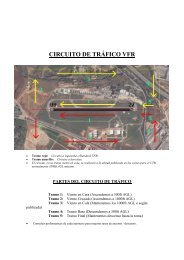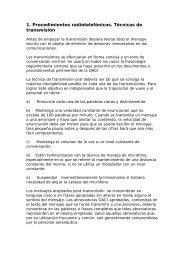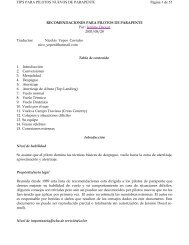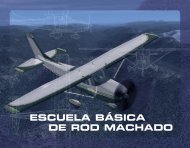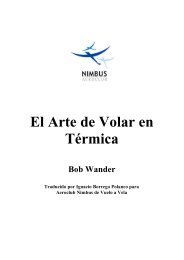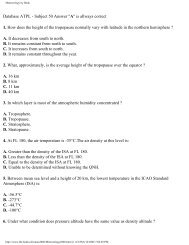ABOUT WINGLETS - Ultraligero.Net
ABOUT WINGLETS - Ultraligero.Net
ABOUT WINGLETS - Ultraligero.Net
Create successful ePaper yourself
Turn your PDF publications into a flip-book with our unique Google optimized e-Paper software.
at negative Cl’s, so that sideslips and horizontal<br />
gusts can be tolerated. The corners of<br />
the laminar bucket have been rounded to<br />
avoid unstable yawing moments that would<br />
be generated otherwise if the sailplane yawed<br />
to angles exceeding those corresponding to<br />
the sharp corners of the traditional Wortmann<br />
sailplane airfoils. Finally, the airfoil was designed<br />
to avoid laminar separation bubbles<br />
down to R e = 350,000.”<br />
WING AERODYNAMICS<br />
The change in the lift distribution of a wing<br />
with and without winglets is shown below. The<br />
boundary condition at the wingtip of the main<br />
wing no longer requires that the lift taper to<br />
zero at the tip. The assumed lift distribution<br />
for a wing with a winglet is assumed to terminate<br />
at an imaginary point equal to unfolding<br />
the vertical winglet in the horizontal plane. As<br />
a result the outer portion of the wing carries a<br />
higher load than it does without the winglet.<br />
Recent calculations on sailplanes with double<br />
trapezoidal planforms such as the ASW–<br />
20 or LS–6 suggest that this outer tip loading<br />
is more efficient from the standpoint of induced<br />
drag.<br />
Secondly, the additional lift capability of the<br />
main wing means that the Clmax of the overall<br />
wing is increased and the sailplane’s circling<br />
performance will be enhanced.<br />
Structural Loading<br />
One of the key advantages of winglets is that<br />
they provide a performance increase while<br />
only fractionally increasing the root bending<br />
moment on the spar compared to a span extension.<br />
Whereas the moment arm of a span<br />
extension is one–half the semi–span of the<br />
wing (about 7.5 metres), the moment arm of a<br />
winglet is only equal to approximately one–<br />
half the vertical span (0.3 m) plus the deflected<br />
wing elevation at the tip. For sailplanes<br />
which are certified with tip extensions, one<br />
can be assured that the winglet will not overload<br />
the wing and all standard operating limitations<br />
will apply (Ventus, ASW–20, DG–600).<br />
8<br />
moment arm<br />
of winglet lift<br />
span loading without winglet<br />
FINAL DESIGN<br />
span loading with winglet<br />
Lift distribution on a wing with and without winglet<br />
The final choice of design parameters is reflected<br />
in the design of the Ventus and ASW–<br />
20 winglets, which have been highly successful<br />
in competition. The ASW–20 winglet went<br />
through two iterations and the Ventus, three,<br />
before it was concluded that the design had<br />
reached a high level of refinement.<br />
FLIGHT TEST RESULTS<br />
Competition Results<br />
The response of pilots flying with winglets in<br />
competition has been very positive overall.<br />
Certainly one of the measures of the success<br />
of the design is the fact that pilots after a<br />
period of evaluation have chosen to fly with<br />
the winglets. At the 1991 World contest in<br />
Uvalde, Texas, ten pilots chose to fly with our<br />
winglets – 8 Ventus, 1 ASW–20B, and 1 Nimbus<br />
III. At the end of the contest, a Ventus<br />
flying with our winglets had won four of twelve<br />
contest days and on the fastest day of the<br />
contest, the top five places in the 15 metre<br />
class went to sailplanes flying with our winglets.<br />
Additionally the trophy for the highest<br />
speed achieved overall went to Jan Anderson<br />
of Denmark, flying a Ventus with our winglets<br />
(his speed also exceeded the highest<br />
achieved in the Open Class). Two weeks prior,<br />
at the 15 metre Nationals in Hobbs, New<br />
Mexico, Reinhard Schramme from Germany<br />
established an unofficial record of sorts by<br />
flying his Ventus–C around a closed course<br />
of greater than 500 km with an average speed<br />
of 171 km/h (he would have won were it not<br />
for a photo penalty).<br />
Bruno Gantenbrink and Hermann Hajek of<br />
Germany chose to retrofit winglets to their<br />
Ventus–C’s and were delighted with the handling<br />
and performance qualities that they observed.<br />
Mr. Hajek noted as a particular advantage<br />
the improvement in his ability to maintain<br />
constant bank angle and speed with a<br />
full load of water. With winglets the effective<br />
dihedral is increased and the sailplane can<br />
be banked steeper while retaining control.<br />
moment arm of lift from span extension<br />
additional lift from wing<br />
in presence of winglet<br />
The dolphining performance is naturally improved<br />
with the winglets since they act to<br />
reduce induced drag while pulling positive<br />
‘g’, and several pilots have perceived their<br />
sailplanes to have improved glide performance<br />
even at high cruising speeds in strong<br />
weather.<br />
Flight Test Data<br />
These positive results are confirmed by flight<br />
tests based on three high tows with each sailplane<br />
type which show the following performance<br />
gains as measured by the two–glider<br />
comparison technique.<br />
ASW–20 flight test data:<br />
(pilots –Striedieck, Seymour)<br />
speed duration Δ with Δ<br />
winglets ft/min<br />
50 mi/h 5 min + 30 ft 6<br />
65 mi/h 5 min + 7 ft 1.5<br />
80 mi/h 2 min + 10 ft 5<br />
100 mi/h 2 min 0 0<br />
Ventus flight test data:<br />
(pilots –Mockler, Masak)<br />
speed (knots) flap Δ with<br />
winglets<br />
40 dry, 53 wet +2 9.1 ft/min<br />
50 dry, 66 wet 0 9.0 ft/min<br />
60 dry, 79 wet 0 9.8 ft/min<br />
84 dry, 110 wet –2 3.3 ft/min<br />
Maximum performance gains<br />
with Masak winglets<br />
sailplane winglet airfoil L/D gain<br />
ASW–20 NASA Van Dam 2.1<br />
Discus PSU–90–125 2.5<br />
Ventus PSU–90–125 3.5<br />
CONCLUSIONS<br />
The overall performance gains measured in<br />
free flight on sailplanes retrofitted with winglets<br />
are impressive and are supported by positive<br />
contest results. Handling qualities are improved<br />
in all cases, including improvement in<br />
roll rate and roll authority at high lift conditions.<br />
The performance measurements have shown<br />
a higher gain in performance than would otherwise<br />
be predicted by conventional theory.<br />
It is believed that major benefits are derived<br />
from inhibiting the secondary flow that contaminates<br />
the boundary layer near the tip region.<br />
Prediction of this phenomenon requires<br />
computational power out of my grasp, and<br />
the present designs have been developed<br />
via experimentation and in–flight testing.<br />
By August 1991, there were over forty–five<br />
sailplanes in the world flying with winglets<br />
designed and fabricated by the author. No<br />
negative reports or dangerous incidents (ie.<br />
flutter) of any kind have been reported. As a<br />
result of the positive service experience,<br />
Transport Canada have recently issued a supplementary<br />
type certificate for flight with winglets<br />
on the Ventus model, using JAR–22 as a<br />
basis for compliance. •<br />
A bibliography is on page 13<br />
free flight 2/92



